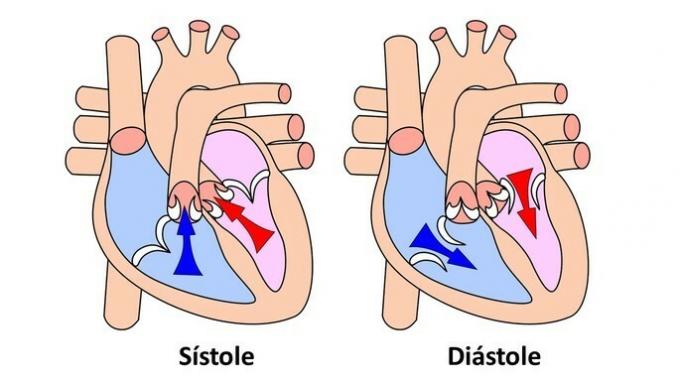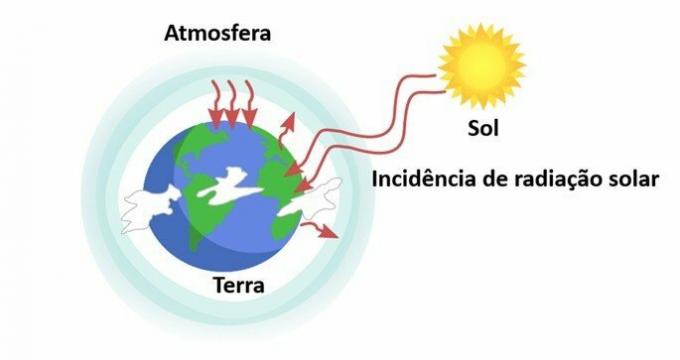The cardiovascular system, also called the circulatory system, is responsible for distributing blood throughout the human body.
Check out a list of exercises to test your knowledge on the topic below, and answer your questions with the comments in the resolutions.
question 1
Tick the alternative that does NOT have a cardiovascular system function.
a) Nutrient transport
b) Elimination of excreta
c) Distribution of defense mechanisms
d) Hormone production
Correct answer: d) Hormone production.
The cardiovascular system's main function is to distribute blood throughout our body.
Through the blood it is possible to transport nutrients, eliminate metabolic waste, transport immune system antibodies and transport hormones produced by the endocrine system.
question 2
About the structure of the cardiovascular system, it is correct to state that:
a) It consists of the heart, blood vessels and blood.
b) The heart, a hollow muscular organ, is located behind the lungs.
c) Blood vessels are composed of striated muscles.
d) Blood is the main organ of the cardiovascular system.
Correct answer: a) It consists of the heart, blood vessels and blood.
The cardiovascular system is formed by a set of organs, heart and blood vessels, through which blood, a living tissue, circulates and conducts substances through our body.
The heart is situated between the lungs, in a region called the middle mediastinum.
Blood vessels are formed by a network of tubes formed by smooth muscles and responsible for conducting blood.
question 3
Regarding blood vessels, it is INCORRECT to state that:
a) They constitute a wide network of tubes through which blood circulates, distributed throughout the body.
b) There are three types of blood vessels: arteries, veins and capillaries.
c) These tubes have different diameters and circulate arterial and venous blood.
d) They are formed by two layers, also called tunics.
Incorrect answer: d) They are formed by two layers, also called tunics.
Vessels are made up of THREE layers, also called tunics. Are they:
- Tunica intima: inner layer formed by endothelial cells and loose connective tissue;
- Tunica media: intermediate layer of smooth muscle cells;
- Tunica adventitia: outermost layer of basically collagen and elastic fibers.
The larger the vessels, such as arteries and veins, the greater the number of cell layers. Smaller vessels, such as capillaries and arterioles, are usually made up of a single layer.
question 4
The heart is the organ responsible for pumping blood throughout the body. For this, the systole and diastole movements, two primordial moments in the cardiac cycle, perform, respectively:
a) contraction, filling with blood, and relaxation, releasing blood into the body.
b) relaxation, receiving blood, and contraction, releasing blood into the body.
c) contraction, pumping blood to the body, and relaxation, filling with blood.
d) contraction, transforming arterial blood into venous, and relaxation, releasing blood to the body.
Correct answer: c) contraction, pumping blood to the body, and relaxation, filling with blood.
Heartbeats are produced in the cardiac cycle.

Systole occurs on the first beat and signals when the heart muscle contracts, which causes blood to be pumped to the body.
Diastole begins on the second beat, when the organ relaxes and starts to fill with blood.
question 5
Look at the image below and identify which cavities are responsible, respectively, for the entry and exit of blood from the heart.

a) Tricuspid and mitral valves
b) Upper and lower vena cava
c) Pulmonary veins
d) Atria and ventricles
Correct answer: d) Atria and ventricles
The atria are the upper cavities through which blood enters the heart. The ventricles, on the other hand, are inferior cavities through which blood flows.
For this to happen, the right atrium communicates with the right ventricle and the left atrium communicates with the left ventricle.
question 6
Blood pressure is directly related to the cardiac cycle and it is INCORRECT to state that:
a) Hypertension corresponds to blood pressure above the ideal.
b) Presents fixed values regardless of the individual's condition, such as pregnancy.
c) Corresponds to the pressure that the blood makes on the walls of the arteries.
d) Arterial hypotension corresponds to values below ideal.
Correct answer: b) It presents fixed values, regardless of the individual's condition, such as pregnancy.
The values presented in the measurement of blood pressure may vary according to the level of stress, physical activity and food consumed.
In addition, the values can vary according to the age group and also in pregnant women the numbers can change, with an increase being more common.
question 7
The heart performs its functions through two closed circuits: the small circulation and the large circulation. These courses are distinguished by:
a) The small circulation passes through the heart only once, while the large circulation has two passages.
b) Blood flow is less in the large circulation and greater in the small circulation.
c) The small circulation takes place between the lungs and the heart, whereas the large circulation takes place between the heart and other parts of the body.
d) In the small circulation there is only the passage of venous blood, while in the large circulation there is only arterial blood.
Correct answer: c) The small circulation takes place between the lungs and the heart, whereas the large circulation takes place between the heart and other parts of the body.
In the full course of blood circulation, blood passes through the heart twice through the small and large circulations.
The small circulation, also called the pulmonary circulation, occurs between the lungs and the heart. Along the way, venous blood, rich in carbon dioxide, is pumped from the heart to the lungs and returns arterial blood, rich in oxygen, to the heart.
The great circulation or systemic circulation happens between the heart and other parts of the body. Arterial blood is pumped to the body and venous blood makes its way back to the heart.
question 8
The circulatory system is classified into two types: open circulatory system and closed circulatory system. The alternative that does NOT show a difference between them is:
a) The closed circulatory system is less efficient than the open circulatory system.
b) In the open circulatory system, the fluid that circulates is the hemolymph and in the closed circulatory system, it is blood.
c) The open circulatory system is present in some invertebrates and the closed circulatory system is part of all vertebrates.
d) In the open circulatory system, there is circulation in tissue cavities and gaps, while in open circulation, the route is carried out inside vessels.
Correct answer: a) The closed circulatory system is less efficient than the open circulatory system.
For transporting the materials necessary for the cells to carry out their activities and taking cell waste from faster way through the vast network of vessels that make up the body, the closed circulatory system is more efficient.
Through vascularization of the closed circulatory system, the exchange of gases and nutrients between cells is favored.
question 9
(Enem/2013) The image represents an illustration taken from the book De Motu Cordis, authored by the English doctor Willian Harvey, who made important contributions to the understanding of the blood circulation process in the body human. In the illustrated experiment, Harvey, after applying a tourniquet (A) to a volunteer's arm and waiting for some vessels to swell, pressed them at one point (H). Keeping the point pressed, he moved the blood content towards the elbow, noticing that a portion of the blood vessel remained empty after this process (H-O).

Harvey's demonstration allows establishing the relationship between blood circulation and
a) blood pressure
b) venous valves
c) lymphatic circulation
d) cardiac contraction
e) transport of gases
Correct answer: b) venous valves.
Arterial blood, rich in oxygen, leaves the heart and goes to different parts of the body through the artery. After gas exchange, venous blood, rich in carbon dioxide, returns to the heart through the veins.
To maintain the flow to the heart, there are venous valves, which are responsible for preventing the occurrence of the reflux of venous blood and thus the blood maintains a unidirectional flow towards the heart.
question 10
(Fuvest/2018) In the human circulatory system,
a) the superior vena cava carries oxygen-poor blood, collected from the head, arms and upper trunk, and reaches the left atrium of the heart.
b) the inferior vena cava carries oxygen-poor blood, collected from the lower part of the trunk and lower limbs, and reaches the right atrium of the heart.
c) the pulmonary artery carries oxygen-rich blood from the heart to the lungs.
d) the pulmonary veins carry oxygen-rich blood from the lungs to the right atrium of the heart.
e) the aorta artery carries oxygen-rich blood to the body through systemic circulation and exits the right ventricle of the heart.
Correct answer: b) the inferior vena cava carries oxygen-poor blood, collected from the lower part of the trunk and lower limbs, and reaches the right atrium of the heart.
The vena cava carries blood from the head, upper and lower limbs, and the abdomen to the heart, where it is received by the right atrium.
The right atrium, which receives venous blood, that is, rich in carbon dioxide and poor in oxygen, communicates with the right ventricle.
To continue your studies, read the texts related to the exercise:
- Cardiovascular system
- Circulatory system
- Heart
- Blood vessels

